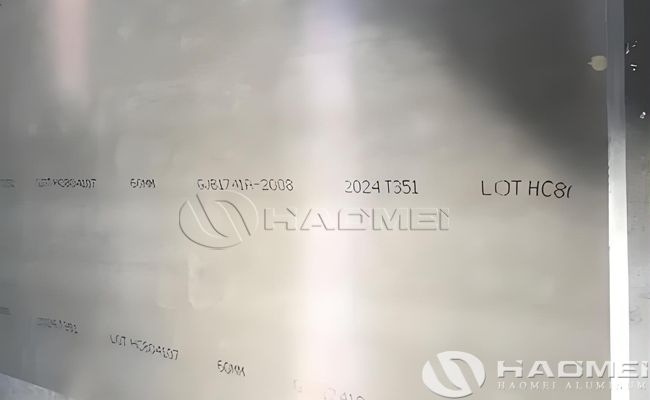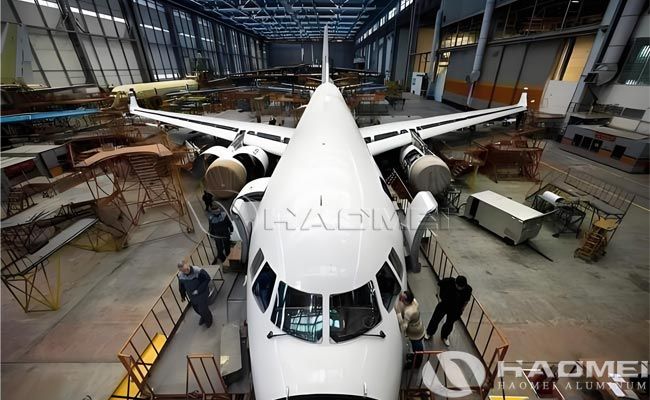
![]() Home > News
Home > News
Source:https://www.aircraft-aluminium.com/a/why-2024-aluminum-sheet-is-used-in-aircraft-construction.html
The core position of 2024 aluminum sheet in aircraft construction stems from its unique material properties that are highly compatible with the stringent requirements of the aviation industry. For example, its strength, fatigue performance, lightweight, processability and applicability.

1. Material performance advantages
(1). Balance of high strength and lightweight
- The tensile strength is 470 MPa, and the yield strength is ≥275 MPa (T351 state), which is significantly higher than ordinary aluminum alloys, and can withstand high loads on aircraft structures (such as wing aerodynamic pressure, take-off and landing impact).
- The density is only 2.73–2.85 g/cm³, which is about 1/3 of steel, greatly reducing the weight of the fuselage. Taking a medium-sized passenger aircraft as an example, using 2024 aluminum sheet instead of steel can reduce weight by several tons, directly improving fuel efficiency by more than 10%.
(2). Excellent high temperature performance
In an environment above 125°C, the strength of 2024 even exceeds that of 7075 aluminum alloy (the latter is often used for parts with higher strength but slightly lower heat resistance), making it an ideal choice for areas near heat sources such as engine compartments and wing leading edges.
(3). Fatigue strength and processing adaptability
- The fatigue strength reaches 105 MPa, which can withstand high-frequency cyclic stresses during flight (such as air turbulence and cabin pressure changes) and extend the life of the structure.
- It has good formability in the annealed or newly quenched state, and is suitable for stamping complex curved surface parts such as skins and rib beams; at the same time, it has excellent cutting performance, which is convenient for high-precision processing of rivet holes and joint surfaces.

2. Specific applications in aircraft structures
2024 aluminum sheets are adapted to a variety of key components through different heat treatment states:
- T3/T4 temper: used for aircraft skins and frames, taking into account both formability and strength;
- T351 temper: manufacturing high-stress components such as bulkheads and wing beams, with tensile strength increased to more than 425 MPa;
- Alclad process (Alclad): the surface is covered with a pure aluminum layer to make up for the corrosion resistance shortcomings (the substrate has poor corrosion resistance), and is used for corrosion protection of the fuselage outer skin.
3. Typical application scenarios of 2024 aluminum sheet in aircraft construction:
- Main load-bearing structure: wing beams, wing ribs - relying on their high yield strength to support aerodynamic loads;
- Connectors: rivets (2024 O temper) - using the plastic deformation ability of the annealed state to achieve reliable fastening;
- High temperature area: engine nacelles, brake cover plates - 150°C resistance to avoid thermal softening failure.
4. Industry verification and trend support
- Market data support
In the aerospace aluminum plate market in 2023, hard aluminum alloys accounted for more than 35% (2024 is the main model), and the market size is expected to reach US$16.2 billion in 2030, with an annual growth rate of 5.5%.
- Technology iteration response
Despite the increase in the use of composite materials, 2024 aluminum continues to occupy more than 40% of the structural weight of mid-range models through improvements in aluminum cladding processes (such as ultra-thin pure aluminum layers) and mixed use with composite materials.
2024 aluminum sheet plate has become an irreplaceable structural material in aircraft construction with its trinity of "high specific strength + heat resistance + mature process". Especially in load-bearing frames, high-temperature components and economical models, its comprehensive performance is still better than emerging materials. In the future, with the advancement of hybrid design (aluminum-composite) and surface treatment technology, the 2024 aluminum alloy will continue to support the dual goals of lightweight and reliability in the aviation industry.